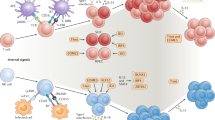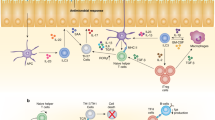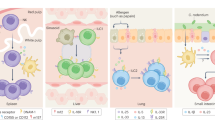Abstract
Innate lymphoid cells (ILCs) are the most recently discovered group of immune cells. Understanding their biology poses many challenges. We discuss here the current knowledge on the appearance of ILC subsets during evolution and propose how the connection between ILCs and T cells contributes to the robustness of immunity and hence to the fitness of the hosts.
This is a preview of subscription content, access via your institution
Access options
Subscribe to this journal
Receive 12 print issues and online access
$209.00 per year
only $17.42 per issue
Buy this article
- Purchase on Springer Link
- Instant access to full article PDF
Prices may be subject to local taxes which are calculated during checkout



Similar content being viewed by others
References
Andral, G. (ed). Essai d'Hématologie Pathologique Fortin. (Masson & Cie, Paris, 1843).
Addison, W. Experimental and Practical Researches on the Blood: Second Series. Prov. Med. J. Retrosp. Med. Sci. 6, 444–445 (1843).
Ehrlich, P. Arch. Anat. Physiol. 3, 571–579 (1879).
Warner, N.L., Szenberg, A. & Burnet, F.M. The immunological role of different lymphoid organs in the chicken. I. Dissociation of immunological responsiveness. Aust. J. Exp. Biol. Med. Sci. 40, 373–387 (1962).
Cooper, M.D., Peterson, R.D. & Good, R.A. Delineation of the thymic and bursal lymphoid systems in the chicken. Nature 205, 143–146 (1965).
DiGeorge, A.M. Congenital absence of the thymus and its immunologic consequences: Concurrence with congenital hypoparathyroidism. Birth Defects Orig. Artic. Ser. 4, 116–121 (1968).
Nossal, G.J., Cunningham, A., Mitchell, G.F. & Miller, J.F. Cell to cell interaction in the immune response. 3. Chromosomal marker analysis of single antibody-forming cells in reconstituted, irradiated, or thymectomized mice. J. Exp. Med. 128, 839–853 (1968).
Kiessling, R., Klein, E. & Wigzell, H. “Natural” killer cells in the mouse. I. Cytotoxic cells with specificity for mouse Moloney leukemia cells. Specificity and distribution according to genotype. Eur. J. Immunol. 5, 112–117 (1975).
Herberman, R.B., Nunn, M.E. & Lavrin, D.H. Natural cytotoxic reactivity of mouse lymphoid cells against syngeneic acid allogeneic tumors. I. Distribution of reactivity and specificity. Int. J. Cancer 16, 216–229 (1975).
Mebius, R.E., Rennert, P. & Weissman, I.L. Developing lymph nodes collect CD4+CD3− LTβ+ cells that can differentiate to APC, NK cells, and follicular cells but not T or B cells. Immunity 7, 493–504 (1997).
Spits, H. et al. Innate lymphoid cells--a proposal for uniform nomenclature. Nat. Rev. Immunol. 13, 145–149 (2013).
Artis, D. & Spits, H. The biology of innate lymphoid cells. Nature 517, 293–301 (2015).
Eberl, G., Colonna, M., Di Santo, J.P. & McKenzie, A.N. Innate lymphoid cells. Innate lymphoid cells: a new paradigm in immunology. Science 348, aaa6566 (2015).
Monahan-Earley, R., Dvorak, A.M. & Aird, W.C. Evolutionary origins of the blood vascular system and endothelium. J. Thromb. Haemost. 11, 46–66 (2013).
Hirano, M. et al. Evolutionary implications of a third lymphocyte lineage in lampreys. Nature 501, 435–438 (2013).
Pancer, Z. & Cooper, M.D. The evolution of adaptive immunity. Annu. Rev. Immunol. 24, 497–518 (2006).
Vivier, E. et al. Innate or adaptive immunity? The example of natural killer cells. Science 331, 44–49 (2011).
Yoder, J.A. & Litman, G.W. The phylogenetic origins of natural killer receptors and recognition: relationships, possibilities, and realities. Immunogenetics 63, 123–141 (2011).
Parrinello, N. Cytotoxic activity of tunicate hemocytes. Prog. Mol. Subcell. Biol. 15, 190–217 (1996).
van de Pavert, S.A. & Vivier, E. Differentiation and function of group 3 innate lymphoid cells, from embryo to adult. Int. Immunol. 28, 35–42 (2016).
Ishizuka, I.E. et al. Single-cell analysis defines the divergence between the innate lymphoid cell lineage and lymphoid tissue-inducer cell lineage. Nat. Immunol. 17, 269–276 (2016).
van de Pavert, S.A. & Mebius, R.E. New insights into the development of lymphoid tissues. Nat. Rev. Immunol. 10, 664–674 (2010).
Boehm, T., Hess, I. & Swann, J.B. Evolution of lymphoid tissues. Trends Immunol. 33, 315–321 (2012).
Igawa, D., Sakai, M. & Savan, R. An unexpected discovery of two interferon gamma-like genes along with interleukin (IL)-22 and -26 from teleost: IL-22 and -26 genes have been described for the first time outside mammals. Mol. Immunol. 43, 999–1009 (2006).
Lane, P.J. et al. Lymphoid tissue inducer cells: bridges between the ancient innate and the modern adaptive immune systems. Mucosal Immunol. 2, 472–477 (2009).
Vondenhoff, M.F. et al. Separation of splenic red and white pulp occurs before birth in a LTαβ-independent manner. J. Leukoc. Biol. 84, 152–161 (2008).
Delconte, R.B. et al. The helix-loop-helix protein ID2 governs NK cell fate by tuning their sensitivity to interleukin-15. Immunity 44, 103–115 (2016).
Constantinides, M.G., McDonald, B.D., Verhoef, P.A. & Bendelac, A. A committed precursor to innate lymphoid cells. Nature 508, 397–401 (2014).
Klose, C.S. et al. Differentiation of type 1 ILCs from a common progenitor to all helper-like innate lymphoid cell lineages. Cell 157, 340–356 (2014).
Robinette, M.L. et al. Immunological Genome Consortium. Transcriptional programs define molecular characteristics of innate lymphoid cell classes and subsets. Nat. Immunol. 16, 306–317 (2015).
Fischer, A. Human primary immunodeficiency diseases. Immunity 27, 835–845 (2007).
Satoh-Takayama, N. et al. Microbial flora drives interleukin 22 production in intestinal NKp46+ cells that provide innate mucosal immune defense. Immunity 29, 958–970 (2008).
Cella, M. et al. A human natural killer cell subset provides an innate source of IL-22 for mucosal immunity. Nature 457, 722–725 (2009).
Rankin, L.C. et al. The transcription factor T-bet is essential for the development of NKp46+ innate lymphocytes via the Notch pathway. Nat. Immunol. 14, 389–395 (2013).
Rankin, L.C. et al. Complementarity and redundancy of IL-22-producing innate lymphoid cells. Nat. Immunol. 17, 179–186 (2016).
Song, C. et al. Unique and redundant functions of NKp46+ ILC3s in models of intestinal inflammation. J. Exp. Med. 212, 1869–1882 (2015).
Nish, S. & Medzhitov, R. Host defense pathways: role of redundancy and compensation in infectious disease phenotypes. Immunity 34, 629–636 (2011).
Tait Wojno, E.D. & Artis, D. Innate lymphoid cells: balancing immunity, inflammation, and tissue repair in the intestine. Cell Host Microbe 12, 445–457 (2012).
Buonocore, S. et al. Innate lymphoid cells drive interleukin-23-dependent innate intestinal pathology. Nature 464, 1371–1375 (2010).
Villanova, F. et al. Characterization of innate lymphoid cells in human skin and blood demonstrates increase of NKp44+ ILC3 in psoriasis. J. Invest. Dermatol. 134, 984–991 (2014).
Scanlon, S.T. & McKenzie, A.N. Type 2 innate lymphoid cells: new players in asthma and allergy. Curr. Opin. Immunol. 24, 707–712 (2012).
Kløverpris, H.N. et al. Innate lymphoid cells are depleted irreversibly during acute HIV-1 infection in the absence of viral suppression. Immunity 44, 391–405 (2016).
Basu, R. et al. Th22 cells are an important source of IL-22 for host protection against enteropathogenic bacteria. Immunity 37, 1061–1075 (2012).
Bouchery, T. et al. ILC2s and T cells cooperate to ensure maintenance of M2 macrophages for lung immunity against hookworms. Nat. Commun. 6, 6970 (2015).
Sonnenberg, G.F. et al. Innate lymphoid cells promote anatomical containment of lymphoid-resident commensal bacteria. Science 336, 1321–1325 (2012).
Hepworth, M.R. et al. Immune tolerance. Group 3 innate lymphoid cells mediate intestinal selection of commensal bacteria-specific CD4+ T cells. Science 348, 1031–1035 (2015).
Mortha, A. et al. Microbiota-dependent crosstalk between macrophages and ILC3 promotes intestinal homeostasis. Science 343, 1249288 (2014).
Hanash, A.M. et al. Interleukin-22 protects intestinal stem cells from immune-mediated tissue damage and regulates sensitivity to graft versus host disease. Immunity 37, 339–350 (2012).
Kruglov, A.A. et al. Nonredundant function of soluble LTα3 produced by innate lymphoid cells in intestinal homeostasis. Science 342, 1243–1246 (2013).
Eken, A., Singh, A.K., Treuting, P.M. & Oukka, M. IL-23R+ innate lymphoid cells induce colitis via interleukin-22-dependent mechanism. Mucosal Immunol. 7, 143–154 (2014).
Acknowledgements
We thank S. Carpentier and N. Thakur for comparative transcriptomic analysis; and P. Golstein, Y. Kerdiles and R. Golub for critical reading and advice. Supported by the European Research Council (THINK Advanced Grant; Vivier laboratory), the Ligue Nationale contre le Cancer (Equipe Labellisée; Vivier laboratory), INSERM (Vivier and Van de Pavert laboratories), CNRS (Vivier and Van de Pavert laboratories), Aix-Marseille University (to Centre d'Immunologie de Marseille-Luminy; Vivier and Van de Pavert laboratories), the Institut Universitaire de France (E.V.), A*MIDEX (Van de Pavert laboratory), Fondation pour la Recherche Médicale (AJE20150633331; Van de Pavert laboratory), Agence Nationale de Recherche (Immunodev; Van de Pavert laboratory), the National Institute of Allergy and Infectious Diseases and the National Institute of General Medical Sciences of the US National Institutes of Health (Cooper laboratory), the National Health and Medical Research Council of Australia (Belz laboratory), the Victorian State Government Operational Infrastructure Support (Belz laboratory), the Australian Government National Health and Medical Research Council of Australia Independent Research Institutes Infrastructure Support Scheme (Belz laboratory) and the Australian Research Council (Belz laboratory).
Author information
Authors and Affiliations
Corresponding authors
Ethics declarations
Competing interests
E.V. is the cofounder of and a shareholder in Innate Pharma.
Rights and permissions
About this article
Cite this article
Vivier, E., van de Pavert, S., Cooper, M. et al. The evolution of innate lymphoid cells. Nat Immunol 17, 790–794 (2016). https://doi.org/10.1038/ni.3459
Received:
Accepted:
Published:
Issue Date:
DOI: https://doi.org/10.1038/ni.3459
This article is cited by
-
Genomic view of the origins of cell-mediated immunity
Immunogenetics (2023)
-
Human induced-T-to-natural killer cells have potent anti-tumour activities
Biomarker Research (2022)
-
The transcription factor RelB restrains group 2 innate lymphoid cells and type 2 immune pathology in vivo
Cellular & Molecular Immunology (2021)
-
Long-chain saturated fatty acids in breast milk are associated with the pathogenesis of atopic dermatitis via induction of inflammatory ILC3s
Scientific Reports (2021)
-
RANKL and osteoimmunology in periodontitis
Journal of Bone and Mineral Metabolism (2021)



